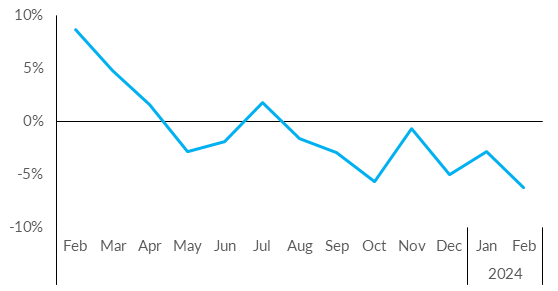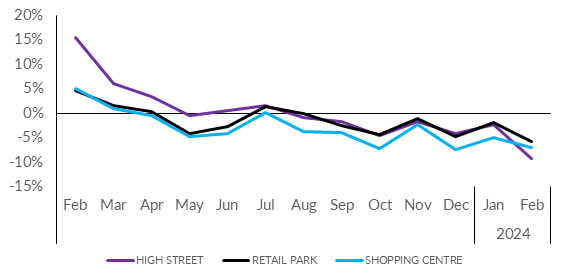Covering the four weeks 28 January 2024
– 24 February 2024
According to BRC-Sensormatic IQ
data:
-
Total UK footfall decreased by 6.2%
in February (YoY), down from -2.8% in January.
-
High Street footfall decreased by
9.3% in February (YoY), down from -2.3% in January.
-
Retail Parks footfall decreased
by 5.8% in February (YoY), down from -1.8% in January.
-
Shopping Centre footfall
decreased by 7.0% in February (YoY), down from
-5.0% in January.
- All UK nations saw a fall in footfall year on year.
Scotland saw the smallest YoY drop in footfall at
-3.2%. England saw a YoY drop in footfall at
-6.6%. This was followed by Northern Ireland
at -7.1% and Wales at -8.0%.
Helen Dickinson, Chief Executive of the British Retail
Consortium, said:
“Footfall experienced its biggest fall since the pandemic. One of
the wettest Februarys on record, exacerbated by train strikes at
the start of the month, meant shoppers visited fewer stores, with
high streets most affected. London, where footfall had been
outperforming other major cities in the UK, saw one of the most
significant declines.”
“With these figures showing the UK underperforming compared to
other developed markets, it’s time the government took action to
drive tourist footfall and spending across the UK. Since the end
of VAT-free shopping for tourists in 2021, the UK has been at a
competitive disadvantage compared to its European counterparts.
With footfall in major hubs trending downwards in recent months,
the Chancellor must reinstate VAT-free shopping in his budget to
support businesses and jobs across the UK.”
Andy Sumpter, Retail Consultant EMEA for Sensormatic
Solutions, commented:
“February saw a collision
course of disruptive forces negatively impacting store traffic,
meaning store visits dipped to their lowest ebb since the
pandemic. Prior to any energy price cap reduction, and
with squeezed spending budgets, the confirmation of the UK’s
‘technical recession’ in 2023 appears to have weakened consumer
confidence. The wettest February on record probably didn't
help, and even Valentine’s Day, which usually provides a frisson
of footfall, failed to woo shoppers into store. With the
Bank of England signalling the UK’s economy may already be
recovering from what it describes as a mild recession, retailers
will be hoping signs of an upturn will translate into store
traffic and spend, with many looking towards the prospect of an
early Easter in March to bring about a change of fortunes.”
MONTHLY TOTAL UK RETAIL FOOTFALL (% CHANGE
YOY)

UK FOOTFALL BY LOCATION (% CHANGE YOY)

TOTAL FOOTFALL BY NATION AND REGION
|
GROWTH RANK
|
NATION AND REGION
|
Feb-24
|
Jan-24
|
|
1
|
Yorkshire and the Humber
|
-1.4%
|
-2.6%
|
|
2
|
East of England
|
-1.7%
|
-2.9%
|
|
3
|
South West England
|
-2.3%
|
-1.3%
|
|
4
|
North West England
|
-3.1%
|
-2.8%
|
|
5
|
Scotland
|
-3.2%
|
-2.7%
|
|
5
|
East Midlands
|
-3.3%
|
-2.2%
|
|
7
|
North East England
|
-3.7%
|
-6.0%
|
|
8
|
West Midlands
|
-3.9%
|
-1.0%
|
|
9
|
South East England
|
-4.8%
|
-3.8%
|
|
10
|
London
|
-6.2%
|
-1.7%
|
|
11
|
England
|
-6.6%
|
-2.6%
|
|
12
|
Northern Ireland
|
-7.1%
|
-6.8%
|
|
13
|
Wales
|
-8.0%
|
-4.5%
|
TOTAL FOOTFALL BY CITY
|
GROWTH RANK
|
CITY
|
Feb-24
|
Jan-24
|
|
1
|
Liverpool
|
1.6%
|
1.5%
|
|
2
|
Leeds
|
1.3%
|
1.5%
|
|
2
|
Edinburgh
|
0.2%
|
3.2%
|
|
4
|
Bristol
|
-2.1%
|
-2.9%
|
|
5
|
Belfast
|
-3.1%
|
-5.3%
|
|
6
|
Manchester
|
-3.7%
|
-2.8%
|
|
7
|
Cardiff
|
-4.2%
|
-4.6%
|
|
8
|
Birmingham
|
-4.4%
|
-2.6%
|
|
9
|
Glasgow
|
-4.6%
|
-7.0%
|
|
10
|
Nottingham
|
-5.0%
|
-5.5%
|
|
11
|
London
|
-6.2%
|
-1.7%
|
-ENDS-
Methodology:
All figures are calculated using precise shopper numbers entering
retail stores across the UK, whichever destination they are
located.
